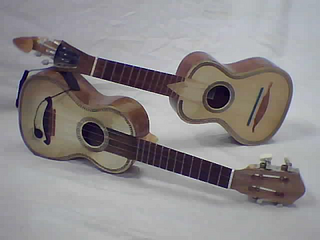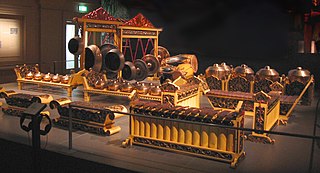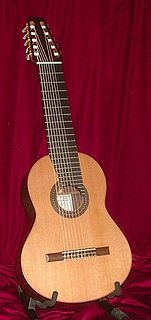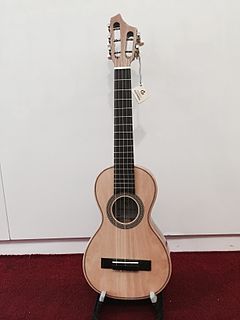Related Research Articles

The ukulele is a member of the lute family of instruments of Portuguese origin and popularized in Hawaii. It generally employs four nylon strings.
The viola is a stringed musical instrument related to the violin. Viola also may refer to:

The cavaquinho is a small Portuguese string instrument in the European guitar family, with four wires or gut strings.
The term requinto is used in both Spanish and Portuguese to mean a smaller, higher-pitched version of another instrument. Thus, there are requinto guitars, drums, and several wind instruments.

A tiple, is a plucked-string chordophone of the guitar family. A tiple player is called a tiplista. The first mention of the tiple comes from musicologist Pablo Minguet e Irol in 1752. Although many variations of the instrument exist, the tiple is mostly associated with Colombia, and is considered the national instrument.

The viola caipira, often simply viola, is a Brazilian ten-string guitar with five courses of strings arranged in pairs. It was introduced in the state of São Paulo, where it is widely played as the basis for the música caipira, a type of folk-country music originating in the caipira country of south-central Brazil.

A folk instrument is a musical instrument that developed among common people and usually does not have a known inventor. It can be made from wood, metal or other material. Such an instrument is played in performances of folk music.
The cuatro is a family of Latin American string instruments played in Puerto Rico, Venezuela and other Latin American countries. It is derived from the Spanish guitar. Although some have viola-like shapes, most cuatros resemble a small to mid-sized classical guitar. In Puerto Rico and Venezuela, the cuatro is an ensemble instrument for secular and religious music, and is played at parties and traditional gatherings.

Kroncong is the name of a ukulele-like instrument and an Indonesian musical style that typically makes use of the kroncong. A kroncong orchestra or ensemble traditionally consists of a flute, a violin, at least one, but usually a pair of kroncongs, a cello in pizzicato style, string bass in pizzicato style, and a vocalist. Kroncong originated as an adaptation of a Portuguese musical tradition, brought by sailors to Indonesian port cities in the 16th century. By the late 19th century, kroncong reached popular music status throughout the Indonesian archipelago.

There are many varieties of ten-string guitar, including:

The Music of Madeira reflects its cultural heritage, this can be seen in the local folklore music, which in Madeira is widespread and mainly uses local musical instruments such as the machete, rajão, brinquinho and cavaquinho, which are used in traditional folkloric dances like the bailinho da Madeira.

The rajão is a 5-stringed instrument from Madeira, Portugal. The instrument traces back to the country's regional folk music, where it is used in folklore dances of Portugal in addition to other stringed instruments from the same region.

Viola braguesa is a stringed instrument from Braga, north-western Portugal. It has 10 strings in 5 courses. The strings are made of steel. It is tuned C4/C3–G4/G3–A4/A3–D4/D4–G4/G4. The scale length is about 500 mm (20 inches).

Viola da terra is a stringed musical instrument from the islands of the Azores, closely associated with the saudade genre of Portuguese music. Its 12 or 15 metal strings are arranged in either five or six courses.
The Viola de arame is a stringed musical instrument from the Portuguese island of Madeira. It has 9 strings in 5 courses. The strings are made of steel.
The viola da Terceira is a stringed musical instrument of the guitar family, from the Portuguese islands of the archipelago of the Azores, associated with the island of Terceira.
The machete is a small stringed instrument from Madeira, Portugal. It has a double bulged body, traditionally made of wood, with a small rib and has four metallic strings, which depending on the region, may be attached by wooden pegs. Its slightly larger cousin, the machete de rajão, has five metal strings. Nowadays, it is not uncommon for the instrument to be made out of linden or poplar. Historians believe the machete was introduced in Madeira from Braga as a braguinha and subsequently brought to Hawaii by Portuguese immigrants in the late 19th century as a possible predecessor of the ukulele.

Lutes are stringed musical instruments that include a body and "a neck which serves both as a handle and as a means of stretching the strings beyond the body".
References
- ↑ "Roots of Rhythm - Chapter 1: The Adufe from Portugal" (PDF). Roots of Rhythm. Retrieved 17 February 2017.
- ↑ Tranquada, Jim (2012). The Ukulele: a History. University of Hawaii Press. pp. 37–39. ISBN 978-0-8248-3544-6.
- ↑ El-Shawan Castelo-Branco, Salwa (2000). "Portugal". In Rice, Timothy; Porter, James; Goertzen, Chris (eds.). The Garland Encyclopedia of World Music / Europe. 8. New York and London: Garland Publishing. pp. 576–603. ISBN 0-8240-6034-2.
- ↑ Almeida, José Lúcio Ribeiro de (19 July 2016), "Viola da Terceira", Instrumentos Populares Portugueses (PDF) (in Portuguese), Lisbon, Portugal, p. 11
- ↑ Introduction Viola da Terra